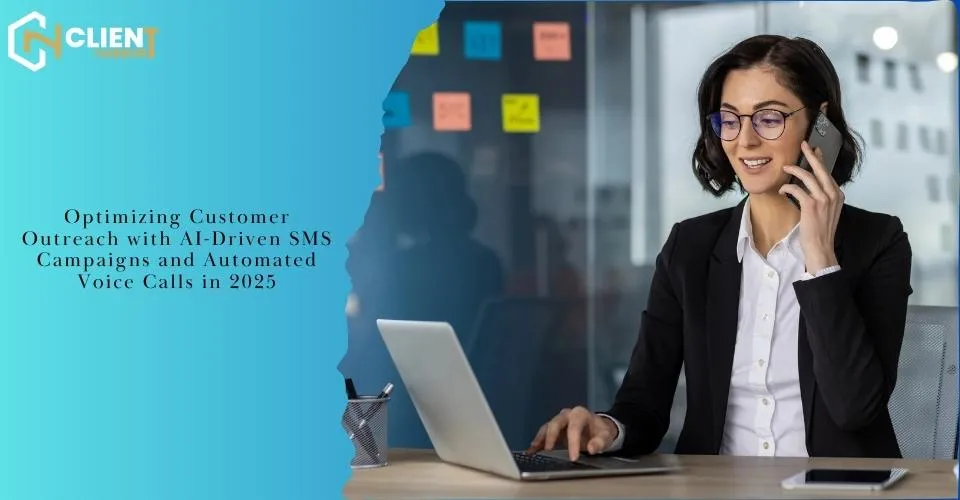
Optimizing Customer Outreach with AI‑Driven SMS Campaigns and Automated Voice Calls in 2025
In this highly competitive market, customer outreach is no longer optional, it has become a necessity. Those whose brands do not perceive prospects and existing customers through as many channels as possible might lag behind. In Client Harbor, we realize that the innovation of high technology automation combined with human orientation is the secret to long term prosperity.
Through AI leveraged SMS campaigns and Automated voice call services, businesses can expand to a greater reach, increase interactions, generate conversions, and maintain minimal overhead costs.
1. Why Multichannel Outreach is important
The expectation of customers is that the brand should talk to them where they are, i.e., through their smartphones, in the form of a text or a voice conversation. A multi-channel strategy:
● Reach is increased: With some customers wanting to use SMS, there are other customers who are more responsive to voice prompts.
● Enhances Engagement: Case-by-case messages drive increased rates of open and response.
● Improved conversion: The use of text reminders and follow up calls leads to action.
Such a comprehensive approach encompassing AI‑powered SMS campaigns and Automated voice calls allows not to lose a single lead.
2. The Strength of AI-powered SMS Marketing
a. Predictive Analytics in Precision Targeting
The new tools are able to detect ideal send times and the perfect content of a message by studying previous interactions; purchase history, browsing pages, and support tickets. The role of predictive models is to dynamically segment the audience so that every recipient will get the most suitable offer.
b. The scaling of Personalization
That was the time of mass-texts that were generic. Artificial intelligence algorithms personalize SMS with the names of the recipients, their location and their interests in the products. Companies have been built up when opening rates soar and opt-out rates decline through the automation of variables, such as using the name (e.g., Hi [First Name] your favorite running shoes are in stock again!).
c. Programmed Answers and Dialogue Trip
The two-way messaging can be used to enable the recipients to respond to the text and get instant AI‑powered responses. Intelligent chat flows enable customers to confirm an appointment, verify order status and answer frequently asked questions without putting additional pressure on support staff and making customers happy.
Tip: To stay compliant with regulations like TCPA and GDPR, always include opt‑out instructions and honor messaging preferences.
3. Elevating Outreach with Automated Voice Calls
a. Intelligent Call Scheduling
Rather than random dialler blasts, AI‑based systems analyze time zone, past pick‑up patterns, and urgency to schedule calls when prospects are most likely to engage. This increases contact rates and respects customer time.
b. Natural‑Language Conversational Agents
Using advanced speech‑recognition and text‑to‑speech engines, automated calls can simulate natural conversations. Whether delivering appointment reminders or survey invitations, these calls sound conversational rather than robotic—leading to higher completion rates.
c. Seamless Handoff to Human Agents
When a customer requests assistance or indicates interest, the system flags the interaction and routes the call to a live agent, complete with context and transcripts. This hybrid model ensures a frictionless experience.
Example: A mortgage lender uses automated voice calls to confirm document receipt; when a borrower indicates confusion, the system transfers the call to a loan officer within seconds.
4. Integrating SMS and Voice for Maximum Impact
a. Coordinated Cross‑Channel Journeys
An ideal outreach sequence might begin with an AI‑driven SMS campaign announcing a limited‑time offer, followed by an automated voice call reminder two days later. By reinforcing messaging across channels, brands nudge customers toward conversion.
b. Real‑Time Analytics and Optimization
Unified dashboards track delivery rates, open rates, response rates, and call completion metrics. AI engines continuously optimize message timing, call scripts, and audience segments to improve ROI.
c. Robust Compliance and Opt‑Out Management
Centralized preference centers synchronize opt‑ins and opt‑outs across both SMS and voice channels. Automated workflows ensure that customer preferences are respected instantly.
5. Implementation Best Practices
Define Clear Objectives: Whether you’re nurturing leads, reducing no‑shows, or collecting feedback, specify your goals up front.
Segment Intelligently: Use AI insights to group customers by behavior, demographics, and engagement likelihood.
Craft Compelling Copy: Keep SMS under 160 characters; for calls, use simple, action‑oriented scripts.
Respect Time and Frequency: Avoid texting or calling too often. Use AI‑driven frequency capping to maintain a positive brand image.
Monitor and Iterate: Continuously review performance metrics and refine your campaigns. A/B test message variants and call scripts.
6. Comparison Table: Traditional vs. AI‑Enabled Outreach
Feature
Traditional Methods
AI‑Enabled SMS & Voice
Audience Segmentation
Manual lists, basic demographics
Dynamic, predictive segments
Message Personalization
Static templates
Real‑time, data‑driven customization
Timing Optimization
Fixed schedules
AI‑based optimal scheduling
Two‑Way Engagement
Limited (manual replies)
Automated conversational flows
Scalability
Staff constraints
Virtually unlimited, cost‑efficient scale
Performance Analytics
Post‑campaign reports
Real‑time insights and continuous feedback
Compliance Management
Manual tracking
Centralized, automated opt‑out handling
7. Case Study: Local Healthcare Network
A regional healthcare provider faced low attendance at routine checkups. By deploying AI‑driven SMS campaigns to remind patients of upcoming appointments and following up with Automated voice calls for no‑response cases, they achieved:
● 30% reduction in no‑show rates
● 20% increase in appointment confirmations
● 40% reduction in staff time spent on manual reminders
This demonstrates how AI‑powered outreach not only boosts metrics but also allows healthcare staff to focus on patient care rather than administrative tasks.
Conclusion
In an era defined by digital expectations, businesses can no longer rely on single‑channel, manual outreach. By harnessing the dual power of AI‑driven SMS campaigns and Automated voice calls, companies can deliver personalized, timely communications at scale—dramatically improving customer engagement and operational efficiency. At Client Harbor, we specialize in implementing these advanced solutions, guiding clients through strategy, execution, and continuous optimization.
Ready to transform your outreach? Visit Client Harbor today and discover how AI‑powered multichannel engagement can elevate your brand’s customer experience and drive real growth.
